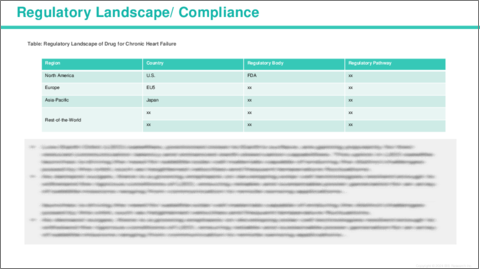|
|
市場調査レポート
商品コード
1759277
慢性心不全の世界市場:地域・国別の分析・予測 (2025-2035年)Chronic Heart Failure Market - A Global and Regional Analysis: Analysis and Forecast, 2025-2035 |
||||||
カスタマイズ可能
|
|||||||
| 慢性心不全の世界市場:地域・国別の分析・予測 (2025-2035年) |
|
出版日: 2025年06月30日
発行: BIS Research
ページ情報: 英文 100 Pages
納期: 1~5営業日
|
全表示
- 概要
- 図表
- 目次
慢性心不全市場の主要な成長要因の一つは、心血管疾患の有病率の上昇です。
高血圧、冠動脈疾患、糖尿病、肥満といった心血管疾患が広がるにつれ、慢性心不全の発症率も上昇し、それに伴って効果的な治療法への需要も増加しています。さらに、高齢化も市場拡大に大きく寄与しています。高齢者は心不全を発症するリスクが高いため、高齢化も市場の拡大に大きく寄与しています。また、診断技術や治療法の進歩により、慢性心不全の早期発見とより効果的な管理が可能になっており、市場成長をさらに後押ししています。SGLT2阻害薬や植込み型デバイスといった革新的な新しい治療法・医療機器の開発は、患者の予後を改善し、それに伴って治療の需要も加速しています。心不全と診断され、長生きする患者が増えるにつれて、より良い治療・管理方法へのニーズも拡大し、慢性心不全市場の成長を促進しています。
市場成長にもかかわらず、いくつかの課題があり、その進展を妨げています。主な課題の一つは、治療費の高さです。新薬の開発、医療機器、入院費など、先進的な治療法は高額になる傾向があり、一部の患者にとって必要な医療を受けることが困難になります。特に、低所得国や新興市場では医療インフラが整っておらず、こうした高コスト治療へのアクセスが制限されています。
もう一つの大きな課題は、治療の複雑さです。慢性心不全は多因子的な疾患であり、その根本的な原因もさまざまで、患者の多くが糖尿病、高血圧、腎疾患などの併存疾患を抱えています。このため、画一的な治療アプローチをとることが難しく、薬物療法と非薬物療法を組み合わせた多面的な管理が必要になります。加えて、病気が慢性的であるため、複雑な治療計画に対する患者の治療遵守率は低くなる傾向があり、その結果、予後の悪化や再入院率の増加を招いています。
さらに、新しい薬物療法が期待されているとはいえ、特定の患者群に対しては依然として有効な治療が不足しています。特に、HFpEF (駆出率が保たれた心不全) の患者には、HFrEF (駆出率が低下した心不全) の患者に比べて選択できる治療法が限られており、この領域には大きなアンメットメディカルニーズが存在しています。
最後に、慢性心不全の初期段階での過小診断や診断の遅れも大きな課題となっています。多くの患者は症状がはっきり現れるまで病気に気づかず、発見が遅れることで予後が悪化し、介入の効果も限定的になっています。慢性心不全を早期に特定し管理することが極めて重要であるにもかかわらず、一部地域では認知度やスクリーニング体制が不十分なため、発見が遅れる傾向にあります。
当レポートでは、世界の慢性心不全の市場を調査し、主要動向、市場影響因子の分析、法規制環境、臨床試験の動向、市場規模の推移・予測、各種区分・地域/主要国別の詳細分析、競合情勢、主要企業のプロファイルなどをまとめています。
目次
エグゼクティブサマリー
第1章 世界の慢性心不全市場:業界展望
- 市場動向
- 規制の枠組み
- 疫学分析
- 臨床試験分析
- 市場力学
- 影響分析
- 市場促進要因
- 市場の課題
- 市場機会
第2章 世界の慢性心不全市場:地域別
- 北米
- 主な調査結果
- 市場力学
- 市場規模と予測
- 欧州
- 主な調査結果
- 市場力学
- 市場規模と予測
- アジア太平洋
- 主な調査結果
- 市場力学
- 市場規模と予測
第3章 世界の慢性心不全市場:競合情勢と企業プロファイル
- 主な戦略・展開
- M&A
- 相乗効果のある活動
- 事業拡大と資金調達
- 製品の発売と承認
- その他の活動
- 企業プロファイル
- AstraZeneca
- Bristol Myers Squibb
- Cytokinetics
- Bayer AG
- Eli Lilly and Company
- Novartis AG
- Pfizer Inc.
- Johnson & Johnson
- Amgen Inc.
- Takeda Pharmaceutical Company
- AbbVie Inc.
- Sanofi
第4章 調査手法
List of Figures
- Figure: Global Chronic Heart Failure Market (by Region), $Billion, 2024 and 2035
- Figure: Global Chronic Heart Failure Market Key Trends, Analysis
List of Tables
- Table Global Chronic Heart Failure Market Dynamics, Impact Analysis
- Table Global Chronic Heart Failure Market (by Region), $Billion, 2024-2035
Global Chronic Heart Failure Market, Analysis and Forecast: 2025-2035
Chronic heart failure is a long-term condition where the heart is unable to pump blood efficiently to meet the body's needs for oxygen and nutrients. This inability to pump effectively leads to fluid buildup in the lungs, abdomen, and legs, causing symptoms such as shortness of breath, fatigue, swelling, and exercise intolerance. chronic heart failure can develop because of underlying conditions such as coronary artery disease, hypertension, diabetes, or previous heart attacks. The condition can be classified into two main types based on heart function: Heart Failure with Reduced Ejection Fraction (HFrEF), where the heart's pumping ability is weakened, and Heart Failure with Preserved Ejection Fraction (HFpEF), where the heart muscle becomes stiff and doesn't fill properly. Chronic heart failure is progressive, meaning it worsens over time, and requires ongoing management with medications, lifestyle changes, and sometimes medical devices or surgeries to improve symptoms and quality of life.
One of the key drivers of the chronic heart failure market is the rising prevalence of cardiovascular diseases such as hypertension, coronary artery disease, diabetes, and obesity. As these conditions become more widespread, the incidence of chronic heart failure increases, driving demand for effective treatments. The aging population is also contributing significantly to the growing market, as older individuals are at higher risk for developing heart failure. Additionally, advancements in diagnostic technologies and treatment options are allowing for earlier detection and more effective management of chronic heart failure, further boosting the market. The development of new, innovative therapies and medical devices, such as SGLT2 inhibitors and implantable devices, is improving patient outcomes, which in turn is accelerating the demand for chronic heart failure treatments. As more individuals are diagnosed and live longer with heart failure, the need for better treatment and management options continues to expand, propelling chronic heart failure market growth.
Despite the growth of the chronic heart failure market, several challenges continue to hinder its progress. One of the primary challenges is the high cost of treatment. The development of advanced therapies, including new drug classes, medical devices, and hospitalization costs, can be prohibitively expensive, making it difficult for some patients to access the necessary care. This is especially true in low-income and emerging markets, where healthcare infrastructure may be limited.
Another significant challenge is the complexity of treatment. chronic heart failure is a multifactorial disease with various underlying causes, and patients often present with comorbidities such as diabetes, hypertension, and kidney disease. This makes it difficult to develop a one-size-fits-all treatment approach, and managing the disease often requires a combination of pharmacological and non-pharmacological interventions. Moreover, the long-term nature of the condition means that adherence to complex treatment regimens is often low, leading to poor outcomes and increased hospitalizations.
Additionally, while new drug therapies have shown promise, there is still a lack of effective treatments for certain subsets of patients, particularly those with heart failure with preserved ejection fraction (HFpEF). This group of patients has limited treatment options compared to those with heart failure with reduced ejection fraction (HFrEF), leaving a significant unmet need in the chronic heart failure market.
Finally, the underdiagnosis and delayed diagnosis of chronic heart failure in its early stages also poses a major challenge. Many patients may not experience noticeable symptoms until the disease is advanced, leading to poor prognosis and reduced effectiveness of interventions. Early identification and management of chronic heart failure are critical, but the lack of awareness and insufficient screening programs in some regions contribute to late-stage diagnoses.
These challenges underscore the need for continued innovation, improved accessibility, and early detection strategies to overcome the barriers to effective chronic heart failure management.
The global chronic heart failure market is highly competitive, with several key players driving innovation and market growth. Leading companies such as AstraZeneca, Bristol Myers Squibb, Cytokinetics, Bayer AG, Eli Lilly and Company, and scPharmaceuticals are at the forefront of the market, each contributing through innovative therapies, medical devices, and treatments. These companies are focusing on expanding the availability of advanced drug therapies such as SGLT2 inhibitors (e.g., dapagliflozin), neprilysin inhibitors (e.g., sacubitril/valsartan), and ARBs, all of which are transforming the treatment of heart failure. Additionally, advancements in medical devices for heart failure management, such as implantable defibrillators and ventricular assist devices, are contributing to better patient outcomes. As these companies continue to invest in research and development, the competition within the chronic heart failure market is driving further innovation, ultimately leading to more effective treatments, improved patient quality of life, and reduced hospitalizations.
Chronic Heart Failure Market Segmentation:
Chronic Heart Failure Segmentation 1: by Region
- North America
- Europe
- Asia-Pacific
The global chronic heart failure market is experiencing significant transformation driven by several emerging trends. There is a growing emphasis on personalized medicine, with advancements in genomic testing and biomarker identification allowing for more tailored treatments that are specific to the patient's unique condition, improving the effectiveness of therapies. Additionally, innovative drug therapies such as SGLT2 inhibitors, neprilysin inhibitors, and ARBs are gaining prominence for their ability to not only improve heart function but also reduce hospitalizations and enhance survival rates, particularly in patients with heart failure with reduced ejection fraction (HFrEF) and heart failure with preserved ejection fraction (HFpEF).
Another major trend is the increasing integration of digital health technologies such as wearables, remote monitoring devices, and telemedicine, which enable continuous tracking of patient health and more proactive management of chronic heart failure symptoms. These technologies help detect early signs of deterioration, prevent hospital readmissions, and optimize treatment regimens. Furthermore, the growing focus on patient-centred care is reshaping the chronic heart failure market by promoting a holistic approach to chronic heart failure management, combining pharmacological treatments with lifestyle modifications, rehabilitation, and psychological support to improve the quality of life for patients.
Table of Contents
Executive Summary
Scope and Definition
Market/Product Definition
Inclusion and Exclusion
Key Questions Answered
Analysis and Forecast Note
1. Global Chronic Heart Failure Market: Industry Outlook
- 1.1 Introduction
- 1.2 Market Trends
- 1.3 Regulatory Framework
- 1.4 Epidemiology Analysis
- 1.5 Clinical Trial Analysis
- 1.6 Market Dynamics
- 1.6.1 Impact Analysis
- 1.6.2 Market Drivers
- 1.6.3 Market Challenges
- 1.6.4 Market Opportunities
2. Global Chronic Heart Failure Market (Region), ($Billion), 2023-2035
- 2.1 North America
- 2.1.1 Key Findings
- 2.1.2 Market Dynamics
- 2.1.3 Market Sizing and Forecast
- 2.1.3.1 North America Chronic Heart Failure Market, by Country
- 2.1.3.1.1 U.S.
- 2.1.3.1 North America Chronic Heart Failure Market, by Country
- 2.2 Europe
- 2.2.1 Key Findings
- 2.2.2 Market Dynamics
- 2.2.3 Market Sizing and Forecast
- 2.2.3.1 Europe Chronic Heart Failure Market, by Country
- 2.2.3.1.1 Germany
- 2.2.3.1.2 U.K.
- 2.2.3.1.3 France
- 2.2.3.1.4 Italy
- 2.2.3.1 Europe Chronic Heart Failure Market, by Country
- 2.3 Asia Pacific
- 2.3.1 Key Findings
- 2.3.2 Market Dynamics
- 2.3.3 Market Sizing and Forecast
- 2.3.3.1 Asia Pacific Chronic Heart Failure Market, by Country
- 2.3.3.1.1 China
- 2.3.3.1.2 Japan
- 2.3.3.1 Asia Pacific Chronic Heart Failure Market, by Country
3. Global Chronic Heart Failure Market: Competitive Landscape and Company Profiles
- 3.1 Key Strategies and Development
- 3.1.1 Mergers and Acquisitions
- 3.1.2 Synergistic Activities
- 3.1.3 Business Expansions and Funding
- 3.1.4 Product Launches and Approvals
- 3.1.5 Other Activities
- 3.2 Company Profiles
- 3.2.1 AstraZeneca
- 3.2.1.1 Overview
- 3.2.1.2 Top Products / Product Portfolio
- 3.2.1.3 Top Competitors
- 3.2.1.4 Target Customers/End-Users
- 3.2.1.5 Key Personnel
- 3.2.1.6 Analyst View
- 3.2.2 Bristol Myers Squibb
- 3.2.2.1 Overview
- 3.2.2.2 Top Products / Product Portfolio
- 3.2.2.3 Top Competitors
- 3.2.2.4 Target Customers/End-Users
- 3.2.2.5 Key Personnel
- 3.2.2.6 Analyst View
- 3.2.3 Cytokinetics
- 3.2.3.1 Overview
- 3.2.3.2 Top Products / Product Portfolio
- 3.2.3.3 Top Competitors
- 3.2.3.4 Target Customers/End-Users
- 3.2.3.5 Key Personnel
- 3.2.3.6 Analyst View
- 3.2.4 Bayer AG
- 3.2.4.1 Overview
- 3.2.4.2 Top Products / Product Portfolio
- 3.2.4.3 Top Competitors
- 3.2.4.4 Target Customers/End-Users
- 3.2.4.5 Key Personnel
- 3.2.4.6 Analyst View
- 3.2.5 Eli Lilly and Company
- 3.2.5.1 Overview
- 3.2.5.2 Top Products / Product Portfolio
- 3.2.5.3 Top Competitors
- 3.2.5.4 Target Customers/End-Users
- 3.2.5.5 Key Personnel
- 3.2.5.6 Analyst View
- 3.2.6 Novartis AG
- 3.2.6.1 Overview
- 3.2.6.2 Top Products / Product Portfolio
- 3.2.6.3 Top Competitors
- 3.2.6.4 Target Customers/End-Users
- 3.2.6.5 Key Personnel
- 3.2.7 Pfizer Inc.
- 3.2.7.1 Overview
- 3.2.7.2 Top Products / Product Portfolio
- 3.2.7.3 Top Competitors
- 3.2.7.4 Target Customers/End-Users
- 3.2.7.5 Key Personnel
- 3.2.7.6 Analyst View
- 3.2.8 Johnson & Johnson
- 3.2.8.1 Overview
- 3.2.8.2 Top Products / Product Portfolio
- 3.2.8.3 Top Competitors
- 3.2.8.4 Target Customers/End-Users
- 3.2.8.5 Key Personnel
- 3.2.8.6 Analyst View
- 3.2.9 Amgen Inc.
- 3.2.9.1 Overview
- 3.2.9.2 Top Products / Product Portfolio
- 3.2.9.3 Top Competitors
- 3.2.9.4 Target Customers/End-Users
- 3.2.9.5 Key Personnel
- 3.2.9.6 Analyst View
- 3.2.10 Takeda Pharmaceutical Company
- 3.2.10.1 Overview
- 3.2.10.2 Top Products / Product Portfolio
- 3.2.10.3 Top Competitors
- 3.2.10.4 Target Customers/End-Users
- 3.2.10.5 Key Personnel
- 3.2.10.6 Analyst View
- 3.2.11 AbbVie Inc.
- 3.2.11.1 Overview
- 3.2.11.2 Top Products / Product Portfolio
- 3.2.11.3 Top Competitors
- 3.2.11.4 Target Customers/End-Users
- 3.2.11.5 Key Personnel
- 3.2.11.6 Analyst View
- 3.2.12 Sanofi
- 3.2.12.1 Overview
- 3.2.12.2 Top Products / Product Portfolio
- 3.2.12.3 Top Competitors
- 3.2.12.4 Target Customers/End-Users
- 3.2.12.5 Key Personnel
- 3.2.12.6 Analyst View
- 3.2.1 AstraZeneca






